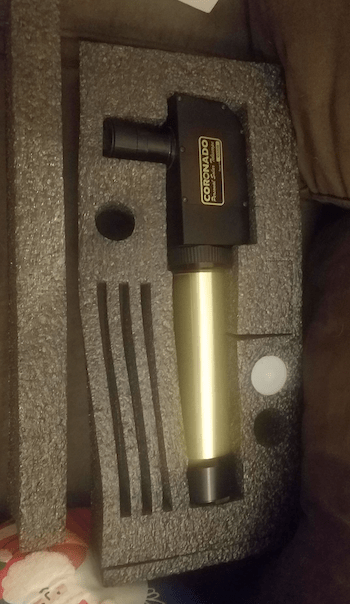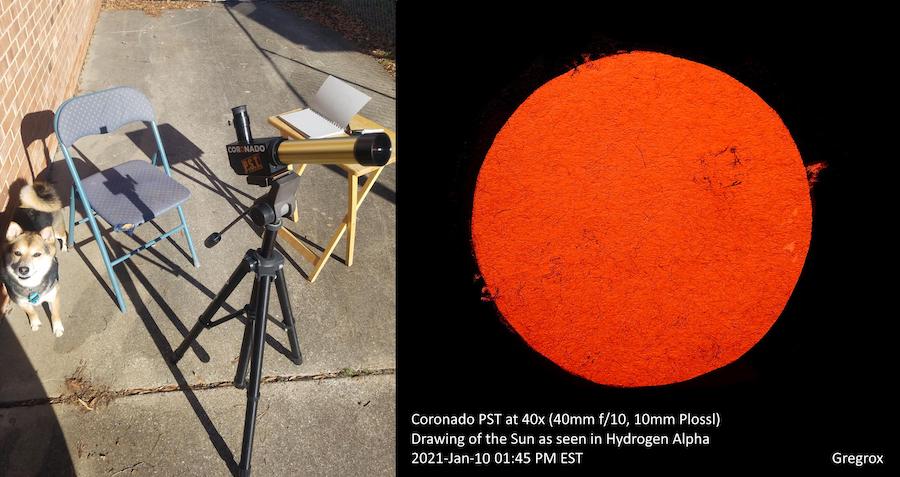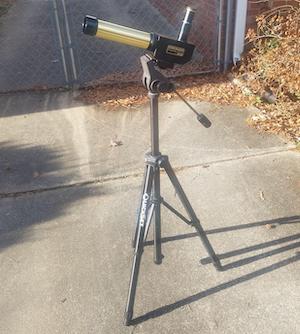Design of Coronado P.S.T

The Coronado P.S.T. uses a 40mm (1.6”) aperture, 400mm (16”) focal length f/10 singlet lens objective, coated to reject the majority of light that hits it. The black box contains an internal etalon filter to transmit a narrow, <0.1 nm (1 Angstrom) portion of the spectrum centered around about 656 nm (Hydrogen Alpha), and a pentaprism provides an erect image at the eyepiece. There is no external focusing mechanism, only a focuser knob at the back of the black box. The front of the black box has a fine-tuning collar/knob to adjust the spacing of the etalon filter to peer into different parts of the Hydrogen Alpha spectrum, allowing you to see structures at different altitudes and compensate for local barometric pressure changes.
The black box also has a built-in pinhole finder, which feeds a tiny image of the Sun onto a small piece of glass, allowing you to align the telescope easily.
The PST has a sweet spot, an area smaller than the whole field of view where the etalon filter is most effective. The tuning collar can allow you to move the sweet spot, or you can move the telescope itself slightly, causing the Sun to move to the sweet spot in the field of view.
The black box contains a ¼ 20 mounting screw hole for use in ordinary photo tripods.
The overall aesthetics are unique to Coronado telescopes: a gold optical tube with black accents. It looks very beautiful, almost like a sort of astronomy bling when compared to the sterile white and black tubes associated with astronomical telescopes or the playfully colorful blue and orange of certain Meade and Celestron telescopes.
Mounting
The Coronado P.S.T. has a variety of mounting options intended by the manufacturer. Coronado used to sell a small, portable altaz mount called the “Malta” which was designed to fit in the carrying case with the PST, but this has been discontinued. Nowadays, you can get either a re-branded EQ-2 mount or an AZS, which seems to be a relative of the AZ3 style mount. Both have matching golden legs and an inflated price tag compared to the generic versions. Coronado telescopes, including the PST, are sometimes bundled with mounts as well.
However, the Coronado P.S.T. is light enough that it can be mounted on a good photo tripod, which is how I use mine. Since it doesn’t reach particularly high magnifications, tracking isn’t an issue; the telescope can be nudged along.
Since the PST has a standard photo tripod screw hole, it can be used on any mount as long as there is a way of adapting it to a ¼ 20 bolt. Any vixen-compatible mount with a vixen dovetail to ¼ 20 bolt adapter will do. However, there is no way to rotate the orientation of the eyepiece relative to the mount, so many single-arm altaz mounts and, in some cases, equatorial mounts, will not be ergonomic.
Accessories
The default Coronado P.S.T. has very little in the way of accessories. It comes with a generic 18mm Kellner (a three-element eyepiece), which is suitable as the PST has a small field of view anyway, and at f/10 a Kellner can perform beautifully. In fact, even non-achromatic Huygens and Ramsdens ought to perform fine, since there’s no risk of false-color fringing.
Meade sells several additional accessories for Coronado telescopes:
CEMAX Eyepieces: These are ordinary Plossl eyepieces (and an ordinary barlow) with a golden casing and slightly different coatings. I don’t own any of these, but many observers report that they’re nearly impossible to tell apart from ordinary night-time eyepieces. Given the marked up price, they’re hard to justify. (I use ordinary Plossls, as well as Goldline eyepieces, and due to their black case and gold band, Goldlines look just like they’re made for this purpose!)
SolarMax II 40mm Etalon: This is a second etalon similar to the one included in the PST, which is designed to go on the front of the PST. This will reduce the brightness of prominences significantly, but it will vastly increase contrast on the chromosphere’s surface. However, this unit nearly doubles the price of the telescope. The double stacking etalon can be bought separately or as a kit with the PST.
Carrying Case: The PST comes out of the box in a nice foam structure for storage, intended to be used with a separately purchased carrying case. This is a hard box that allows the telescope to be carried-on on airplanes, carried compactly for eclipse expeditions, or for solar outreach. It is not essential, though storing it in the foam is a good idea.
At f/10 with no chance of chromatic aberration, you may in fact struggle to find eyepieces that give a bad image–choose on the basis of affordability, magnification, and comfort.
Observing with the Coronado P.S.T.
The Sun in Hydrogen Alpha is one of the most enticing objects in the solar system to observe. It will never be the same from one day to the next (at least, as long as it’s not an uneventful solar minimum), so you can usually see something new and interesting if you observe every day. The biggest problem with the PST is that it’s so darned small. 40mm aperture is… restricting. However, what you can see with those 40 mm of aperture is so enticing that it will make you wish you had enough money to buy a larger solar telescope–but the PST is the only solar telescope that is even remotely affordable.
Hydrogen-Alpha images published by astronomers (amateur or otherwise) tend to color their images in pleasing orange-yellow-white gradients, however, through the eyepiece the Sun is a pure red ball. Darker shades are dark red, while lighter shades are bright red. There is no yellow, orange, white, or pink. As your eye adjusts, the hue may appear to change to orange, but this is an illusion. It can take some getting used to, and as with all objects you can see in a telescope, experience matters a lot. You will get better at seeing fine details over time, and the best way to train your brain to see details is to record what you see through the eyepiece in a sketch.
As with all visual astronomy, the best way to demonstrate what you can see is not photographs, but sketches. Here are a few from the period between Christmas 2020 and mid-January 2021. Note that these sketches represent a time not too long after solar minimum–the Sun can get to more impressive heights of activity, and it can get down to much less eventful periods when the Sun is nothing more than a textured red ball. Solar activity can be tracked and valuable data monitoring the variability of the Sun is regularly contributed by amateurs. One note about the sketches: my methods do not possess the same resolution as the views through the telescope–often I find it difficult to capture fine detail in prominences, so the views here should be taken as suggestive but not as exactly what you see.

Through the telescope, most chromospheric structures can be detected and observed. Spicules and their larger cousins, Prominences and Filaments, the chromospheric web and granulation, bright plages, and dark sunspots. Sunspots show very different detail in H-alpha compared to white light, and are often surrounded by bright plages and thin dark filaments. Adjusting the etalon filter allows you to see structures at different heights in the chromosphere, and the disk can look quite different in the center of the h-alpha spectrum compared to the “wings.” The etalon can also be grossly maladjusted so you can observe the photosphere of the sun in red “continuum” light. This can allow you to tell the difference between sunspots and dark chromospheric features when it may be ambiguous. Prominences are some of the coolest things to observe in the whole solar system, and it seems like anything is possible. They come in lots of different shapes and can be observed to change shape over the course of days–or in some cases, hours. Filaments are prominences seen edge-on against the chromosphere disk and come in interesting shapes as well. The most striking of these are the long, thin, hairy loops.
With a small telescope, observing the Moon never gets old, exactly, but you eventually discover all there is. If you miss one night, you know the Moon will return to the same phase in a month. But with the sun? Every day is unique. There will never be another sun like today’s. But maybe there will be more interesting views to come. The Sun never ceases to reward observing, especially if you can keep a detailed record to see the sun change over time. Without photography, that means keeping sketches. I recommend sketching on gray paper with black and white media, so you can capture both dark features and bright features.
The Coronado P.S.T. is only able to be effectively used for visual work. Solar photography can’t be done without modifying the telescope or the camera, as there just isn’t enough focuser in-travel for a DSLR or planetary camera to reach focus. Even if it could, the sweet spot would be smaller than the field of view, meaning the images would have a banded appearance. Multiple images with different etalon tunings could be used, but this complicates things further. It is the only affordable option for solar photography, but like all cheap astrophotography, cheap is more difficult. Smartphone astrophotography isn’t any better–I don’t even know what my smartphone is doing, but it seems that color sensors don’t know how to interpret intense single-wavelength light as anything other than a fuzzy magenta mess.
Observing during the day presents different conditions to evening viewing. For example, the eye pupil will only open to around 2-2.5mm in bright light, which means the minimum magnification of a solar telescope (before which you begin losing light) is higher than a night time telescope of the same aperture. A 25mm Plossl–standard in many telescopes–is actually too low a power. However, it is preferred for outreach, since the lack of any kind of background makes it much harder to locate the Sun image in the eyepiece to an untrained observer’s eye. Oversizing the exit pupil makes it easier to find the Sun and see it in its entirety.
Observing during the day means your eyes will be adjusted to brightness, and it will be difficult to observe faint structures on the Sun, especially at high magnification where the brightness goes down dramatically. I observe with my hoodie draped over the entire telescope, and my observing eye remains closed when not looking through the eyepiece. This could potentially get pretty hot in the summer–consider getting a sunshade, or a white piece of cloth. Just be sure you don’t cover the objective!
The Coronado P.S.T. can magnify up to 80x before you reach empty magnification. This would be provided with a 5mm eyepiece. The minimum magnification before you start losing light will be around 20x, provided by a 20mm eyepiece–which is why the telescope comes with an 18mm Kellner. Up to 26x, the view is bright enough to suffice for a quick look. I often use a 15mm Goldline when I want a quick peek. However, it is much higher than that and the view is darkened enough that you will need to start planning around dark adaptation and shading your view.
I have occasionally observed at 67x with a 6mm Goldline eyepiece. Prominences scarcely show more detail at this power (it’s too dim), but when the seeing conditions are good, high powers reward views of spicules, granulation, and filaments.

